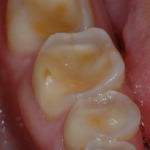Overview
Welcome our site for dental professionals and dental teams. Erosive tooth wear is the 3rd most commonly observed oral condition[1] and should be part of every clinical examination. These pages contain information about the condition supported by education assets for you and your colleagues.
Reference 1. Bartlett et al. Prevalence of tooth wear on buccal and lingual surfaces & possible risk factors in young European adults. J Dent 2013; 41: 1007-1013.
Quick Links
ETWF Updates
Join our LinkedIn community to engage with leading experts, share your experiences, and stay informed on the latest research and solutions for better oral health.
About Erosive Tooth Wear
What is Erosive Tooth Wear?
Erosive tooth wear is a term used to describe the effects of erosion, or erosion with attrition and or abrasion. It is rare that a single cause of tooth wear occurs, and most commonly it’s due to a combination of causes. In most cases erosion is an underlying feature of tooth wear and the definition acknowledges this. But we use the term to describe all forms of wear including attrition and abrasion.
Erosion is the loss of enamel and dentine caused by acids in the mouth present from the diet, the stomach or, rarely, industrial sources. Attrition is the loss of enamel and dentine caused by the action of tooth against tooth. Abrasion is the loss of enamel and dentine caused by the mechanical action of surfaces other than teeth
Erosion starts with early demineralisation of the surface enamel, leading to softening; if conditions are appropriate, the softened surface can be remineralised resulting in no damage. But in the presence of abrasives or attrition the softened surface can be lost causing tooth wear.
The remineralising sources are found in saliva, toothpastes or mouthwash. If the frequency of acid bathing the teeth is more than 3 or 4 times a day, the risk of loss of enamel or dentine is increased
Continued or repeated acid demineralisation overwhelms the protective features of the mouth and causes irreversible loss of mineralised tissue
Early signs of erosive tooth wear are the loss of surface structure from the crown of the tooth such as mamellon and surface form
While in some cases they are visible, the early signs of erosive tooth wear are difficult to compare to normal unworn teeth.
Visual Signs
Anterior Teeth (front teeth)
As the condition deteriorates, the clinical signs of erosive tooth wear are easier to visualise; the incisal edge is reduced in height and width and in relatively late conditions it can become translucent.
If the palatal areas of the anterior teeth are left without support from the dentine it can collapse and as a result the teeth become shorter, as noticed by both patient and dental health care professional.
Once the enamel is lost the yellow dentine can be seen.
Posterior Teeth (back teeth)
The early signs are often seen on the occlusal surface of the first molars. The mesio-buccal cusp is often worn away to expose the dentine, which is seen as a yellow cupped-out lesion. There will remain islands of enamel within the cupped out lesions but the dentine is exposed.
If the condition is uncontrolled, the cupped out lesions, which develop over the occlusal surface, start to join resulting in a wider lesion.
Further loss of tissue can lead to the loss of crown height when it becomes noticeable by patients. Most patients do not recognise the loss of tooth structure on posterior teeth and the dentist will be the first to record this.
Distribution
It is not completely understood why the upper central and first molar teeth are the first to be affected.
It is possible that as these are the first teeth to erupt in the adult dentition, early erosive tooth wear damages the still relatively early mineralised surfaces. With increasing age, the condition can be more widespread.
Epidemiology
Erosive tooth wear is common. In one study, around 30% of adults in seven European countries had evidence of erosive tooth wear visible to dental examiners (BEWE 2 or 3). Other European studies have also reported that the condition is prevalent.
Studies in Arabic countries, South America and Asia have reported similar findings
The BEWE allows the dentist to screen for erosive tooth wear. In short, Grade 0 is no wear, Grade 1 is early signs of enamel change (which is the most difficult to distinguish from unworn teeth), for Grade 2, less then 50% of the surface is affected, there are noticeable changes to the shape of anterior or posterior teeth and dentine may be exposed and finally Grade 3 is where the change is greater than 50% and there are severe levels of tooth wear.
Risk Factors
One of the most common ways to wear away the tooth is by drinking and eating acidic drinks and foods outside meal times.
A number of drinks and some foods can contribute to erosive tooth wear but the amount of times you consume these, especially by frequent snacking, can also influence the amount of erosion.

Fruit

Fruit-based drinks containing citric acid

Carbonated drinks

Alcoholic drinks

Acidic Sweets

Other foods
Other causes can include:
Prevention & Treatment
Use of Fluoride/other oral care products
- Fluoride toothpaste and mouthwash aid in prevention.
- Fluoride can also be delivered as sodium, stannous or rarely other forms of fluoride. Access the knowledge base for further information.
- Adult toothpaste (in Europe ) contains up to 1450 ppm of fluoride. Mouth rinses contain less concentrated levels of around 200-450 ppm
- Calcium-based products aim to replace and remineralise surface damage.
- Erosion-formulated products may reduce the risk of erosive tooth wear
Lifestyle adjustments
- Dietary control and eliminating snacking on acidic foods and drinks will reduce the risk of progression.
- It is best not to brush your teeth immediately after eating or drinking acidic foods. The research supporting this statement is not robust and there remains discussion, but at the present time the best advice is to avoid brushing immediately after acidic foods and drinks.
Treatment
- If the condition progresses to severe levels, restoration of teeth may be appropriate
- Restoration may be assisted with composite resin or crowns/onlays
Looking for further information and resources for your patients?
Our Patients page is designed to help your patients understand what Erosive Tooth Wear is and how it can affect them, (without any complicated science!).






